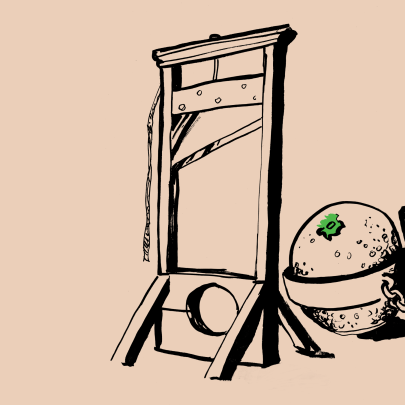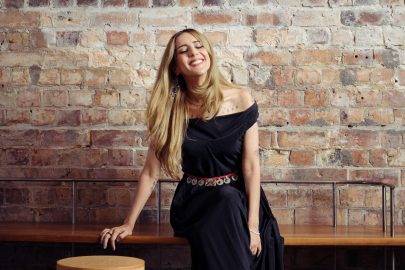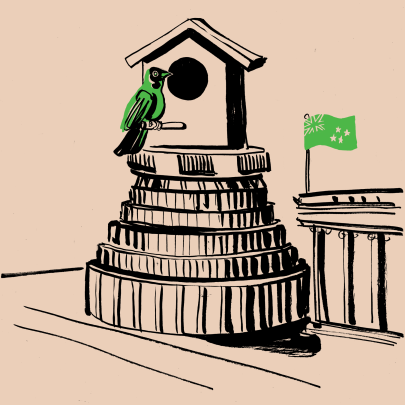Feb 23, 2015 Politics
In 2004, Simon Wilson left a job at the sober Consumers’ Institute in Wellington to edit the glitzy Cuisine magazine in Auckland. After three years here, there are many things he likes but he still can’t fathom why the city doesn’t have a beating heart.
This story was first published in the May 2007 issue of Metro. Illustration by Jed Tallo.
Auckland can be its own worst enemy. At a party in the Viaduct, the restaurateur makes a marvellous speech — I’ve heard few other people talk so entertainingly without notes about their own lives. But he cannot stop himself from punctuating the tale with the clang of dollars. Those super-yachts he’s sailed in, the kitchen equipment he’s got out the back, the tycoons whose feet he has washed… he seems less impressed by the things than by how much they all cost.
At last year’s Auckland launch of Wellingtonian Lloyd Jones’ much-hyped book Mister Pip, which is a brilliant riff on Great Expectations, the chat among the serious literary types is about how Jones might really have chosen a better Dickens. And there’s a celebrity author noisily harrumphing her way through the speeches. Trouble coping because the event is not about her?
But still, I’d rather be here than in Wellington. I went back a few months ago and walked the length of the inner city in half an hour. The weather was welcoming, the harbour beautiful, and when I got to the end I wanted to head straight back to the airport. I grew up in Wellington and it’s too small. In fact, it’s hardly any bigger than it ever was. How can that be?
In Auckland, many things are hard to understand. Like the dress code. For women it’s easy enough — you wear something new season and so badly fitting your underwear shows. But for men? Ties are required on rare occasions, but it beats me when. We should tuck in our shirts, says Wendyl Nissen, but she cannot possibly prefer the big-bums-in-pants look, lumpily enhanced by the wallet in the back pocket. The fashion for pink on a man is good. Did ever a colour look so surprisingly butch?
Theatre doyen Raymond Hawthorne told me the thing he likes about Auckland is the mess. I agree. You can get lost in it, make choices, be surprised. Okay, so it whacks you in the kidneys with the criminal state of its civic planning. But then shyly, magnificently, it redeems itself with the beauty of its parks and water and that lovely, lovely Rangitoto Island. And with its friendly people.
I’m serious, they really are friendly. People chat happily in shops all over town. On both occasions when I’ve witnessed the Indian attendants at my local service station being racially abused by customers, others have spoken up to support them. I love that. And drivers will invariably let you out of a side-street to join a stream of slow-moving traffic. I love that too.
I know, they also mount pedestrian islands in the middle of Ponsonby Rd and knock people down. Some are friendly, others outrageously stupid. The town planners, I suspect, are both. I’m sure they’re good hearted, but why are people still getting run down on Ponsonby Rd? There’s no other town in this country where a retail strip with a track record that bad would be allowed to stay so dangerous.
Why no properly fenced and planted median strips for people to stand in? Extra crossings would help, and wider pavements, even judder bars. Apart from the obvious fact that lives would be saved, can’t they see that the much-fabled Ponsonby Rd is still only a hint of the really great precinct it might become? I know what the objection is: how would the traffic cope? Good lord. Why is that the big question?
Transport. Maybe you just have to laugh. Out in the eastern suburbs, Selwyn College takes students from all over the city and there is a railway line running conveniently past its back fence. But there’s no station! What kind of train service doesn’t regard school kids as core business? What were they thinking?
And that, it strikes me, is the defining question for Auckland. What were they thinking, on that fateful day when Mayor Robbie proposed a city rail system and they turned him down? Vision? No thanks. Not from such a little man. Who does he think he is?
So many problems now, so many cars going nowhere slowly, and all down to that single, small-minded, silly decision. That failure of the imagination.
Which is, I suspect, the usual problem with town planning. Not the planning, the nuts and bolts of how you do things, but the ability to dream up a really good thing to do.
Imagination shouldn’t be a problem in Auckland. This is a city of artists. Home to the Finns, Jacqueline Fahey and Oscar Kightley, Pip Cheshire and Pita Sharples, all those Hawthornes, Hamish Keith and Ngila Dickson and the Jubilation Choir. And it’s stuffed to overflowing with the commercial creativity that follows in the artists’ wake — the ad agencies, the fashionistas, even the restaurateurs.
But the whole adds up to less than the sums of its parts. Why? Like all cities when they get big enough, Auckland is composed of separate tribes, but the trouble here is that the best and brightest of the tribes do not share their city with each other.
When a city thrives, it pays to follow not just the money but also the arts. In Wellington, dare I say it, the money tribe and the arts tribe rub along together, without snobbery, and in consequence, even though it is far too small, the city is still greater than the sum of its parts. Recent Wellington councils, and especially their mayors, have made it their business to ensure this is so.
In Auckland, artists have probably lost faith in Dick Hubbard and they always despised John Banks — and he them. There is a barely disguised war among the tribes — between the money tribe, that is, and not just the arts tribe, but almost everybody else.
The mayors and the various councils, sometimes ineptly, sometimes deliberately, fuel this war. It was the unsubtle subtext of the waterfront stadium debate and it is going to get big and ugly as soon as the Ngati Whatua treaty claims burst back into the media. They can do better. It is the ongoing theme of everything the brilliant Brian Rudman writes in the Herald.
Yet we are all tribal, and most of us here are immigrants to boot — even if that means we’ve come from some other part of New Zealand. We brought the best with us as well as the worst, and whatever Auckland is has been forged from all of it. Take, say, the Topp Twins or Joe Rokocoko, local heroes whose family farm and Fijian village are important to who they are and have become part of the collective consciousness of what we all are as a city.
Take Carlos Spencer, the rural Wellingtonian who ran away to become the very embodiment of Auckland. But that arrogance he showed in Christchurch, when he strolled out to the corner to score and then nailed the conversion. Bloody Jafa? I think of him then as the twinkle-toed kid from the Horowhenua cow paddocks with a different haircut. Mostly, Auckland isn’t special. It’s the rest of the country dressed up for show.
Except when it comes to schools, about which Auckland has an obsession all of its own. Despite appearances, I doubt it’s because of the education on offer. Most kids would get the same amount of the curriculum stuffed into their heads wherever you put them.
In my experience, what Aucklanders really care about in choosing a school is who their kids will meet. It’s about joining the right tribe. And if this is fairly obvious for Auckland Grammar and Kings, it is also true for Western Springs and Tangaroa College.
However, watch this space. Now property has become cheaper by the square metre in Remuera than in Grey Lynn, will there be a collective drift of liberals to the other side of the city, where they can live in bigger houses and have a pool? In return, will developers pull down the villas of the inner west and replace them with kitset condos for the sons and daughters of old Remmers? And what will happen to the “good” schools then?
Both despite and because of the tribalism, multiculturalism is alive and deeply affecting in this city, and it seems to have triumphed over its old adversary, biculturalism. Something about the waves of Pacific and Asian immigration has rendered that debate almost meaningless. If you don’t believe me, check it out in bro’Town.
As for the schools, though, my kids tell me that except for the Chinese and white kids, who mix, the tribes stick pretty much to their own. Despite the hard work of the schools themselves. In one astonishingly good intermediate pageant I attended, a group of kids travelled the world to discover the legacy of many ruinous old conflicts. The big challenge was: how does your cultural identity allow you to live as yourself, not just in your own tribe, but among others?
This is a complex question and the answers can be transcendent. The play clearly suggested that this country had big things to learn from places like India and South Africa.
At the end of it, a kuia with an iridescent crimson rinse through her hair got up to speak. This was Titewhai Harawira, whose grandson had been one of the performers. I thought the play had pointedly critiqued many of her views on both race relations and respect for other people, and I admired the guts of the (mainly Maori) teachers responsible for it. Harawira seemed more than happy just to share some warm fuzzies.
The place I’ve discovered where people from different tribes will be more included than almost anywhere else is kids’ sport. In Auckland, the Samoans (and Papakura South Africans) play rugby, Maori league and the skinny white kids play soccer, but there’s nothing but a warm welcome for anyone who crosses over.
Sure, I’ve seen the bad behaviour from the sidelines, and if you’re reading this on Waiheke Island, I apologise again for having shouted at your referee. But I’ve coached kids’ rugby for many years and I know that while getting worked up about the ref is commonplace among parents and siblings, abuse is not a defining characteristic of the sport.
Besides, there’s nothing to beat Cox’s Bay on a fine Saturday morning in winter. The number two home ground for the Ponsonby club, which we joined, is the best club in the world, they boast, with an All Black lineup to prove it. Dew steaming off the grass, yachts marooned on the mudflats, and Bryan Williams out for a chat, maybe staking out the playing fields with a trundler of corner flags. That’s B.J. Williams — club leader, factotum, middle-aged like me, hero. What a treat. The kids don’t rate it, of course, but all us dads, we definitely do.
What people say about Auckland — what they have always said — is this: the weather’s good, the people are shallow, the traffic’s fucked and the city has no heart. True, false, true, extremely bloody true.
Actually, that weather one is doubtful now. But really, why does everyone think it would be so hard to give this town a heart? To create, down on the waterfront of course, some big public amenities and great open spaces with really neat things in them, alongside a whole lot more of the commercial and recreational activities that already dominate the place?
All it needs is politicians with the political will to deal to the port authority — and to the petty-minded recalcitrants in their own ranks — and truckloads of imagination. We could have a skateboarding heaven swung out over the water. Art that makes you laugh with delight; art so powerful you can’t look away. A bar hung under one of the wharves, and a kids’ adventure playground too. Something truly thrilling completely underwater — ask A.J. Hackett to invent it.
Moving the art gallery down there is a no-brainer, and so is a modern science museum with some mind-boggling, large-scale interactive stuff dreamed up for the purpose. Regular public events, of which fireworks displays, outdoor concerts and boaty things for kids should be only the start. And (just slipping this in here) a really big venue for special events.
It needs this. You have to draw tens of thousands of excited people down to the beating heart of the city several times a year, to attend their event and also, before and after, to make whoopee with everything else on offer. Architecturally magnificent, which means designed in a way that nobody thought about before. A great strange new thing that will be misunderstood until it is built, when presto, it defines the splendour of the whole place.
The tragedy of the waterfront stadium debacle was that Trevor Mallard and Dick Hubbard — and all their overpaid PR flaks — thought it was a rugby stadium and not our own dream of a beating civic heart they had to sell back to us. Idiots.
This would help fix the traffic problem too, you know. The single most important fact about public transport is this: “If you build it they will come” does not apply to trains.
Trains don’t create demand. You need the demand first. So why don’t we find ways to really stuff Auckland’s new waterfront heart full of people, and get them all clamouring for a ride home. Then we’ll get decent light rail.
Is there a thread that ties it all together, all this tribalism and traffic, the sailing and the civic squabbling? How about this: too much of Auckland business is a branch of Sydney business.
In the field I know best, magazine publishing, it’s no accident that great titles are invariably started by small-scale entrepreneurs — individuals whose big reason to get up in the morning is to make a good idea happen. Cuisine, where I worked, and Metro both began life this way and are the outstanding examples in New Zealand.
In contrast, big companies, especially if you’re just the local branch, are more likely to have a join-the-dots approach, and they employ a cadre of managers whose job is to ensure everyone stays with the dots. Make the short-term profit targets, eliminate risk, keep your imagination to yourself. It’s a recipe for not very much at all.
Manifestly, not all of Auckland business functions this way. But I’ve heard enough similar stories in my three years of living here to know it’s not unusual. When I look for reasons why Auckland adds up to less than the sum of its parts, why its money tribe seem so bereft of visionary engagement with the rest of the city, the corporate branch syndrome seems like the right place to start. Too many businesses are here only to make some easy money. Out of us.
In Wellington we lived with the sparkling harbour all before us, but we were on a windswept hilltop and when the southerly blew the planes came rocking past lower than our bedroom window. At six in the morning.
Here, we bought a house half the size and twice the price, and you can definitely hear the motorway. But we are close to town and have a tropical garden with yellow tamarilloes, a frighteningly big banana palm, gorgeous canna lilies, bougainvillea that was a warmer red this summer than last.
There are many nikau, some of which sprout bright pink seaweedy appendages from their trunks. Other palms have glorious orange-brown seedheads standing like great bunches of Jaffas proud above the foliage. And the best of all have leaves so big and heavy you hear a whisper-clunk, even inside the house, each time one drops to the ground. I swear the giant fleshy-leaved plants by the front steps move in the night, so each morning it is a little harder to get out to the street. Sometimes there are tuis. It’s lovely.





